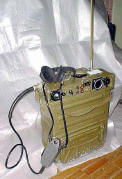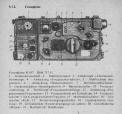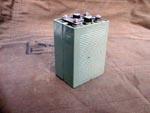













|
|






 
 
Technical data:
- Mass + weights:
- Radio: L/b/h: 375 x 1850 x 270 mm; 16.9 kg.
- Wooden box: L/b/h: 615 x 340 x 460 mm; 45 kg.
- Transmitting power
- 1 Watt.
- Frequency departure
- + - 6 kHz, which can be controlled with the inserted xtal
calibration generator.
- Sensitivity,
- under 1,0 UV with signal-to-noise ratio of 20 dB
- Sections of the radio:
- Wooden box with:
- Radio R-107, 1 laryngeal micro set, antenna bag, 1 Kulikow
antenna, counterweight, attachment framework, mounting plate for
issued antenna, 2 stretcher belts, 6 parts for 2,7-m- rod antenna,
Koax feeder, diodes.
- In the radio operator`s bag,
- Telephone handset, long wire antenna, hand lamp, screwdriver.
- In the antenna bag:
- Long wire antenna (Beverage), 40 m, 6 timber columns, 4 herrings
with anchoring wire
Frequency band:2
frequency band: 1. 20-36.0 and 2. 36-52Mhz
4 mecanical programmable frequencies.
Batteries:
2 times HKN-20. 12 hour standby with 5%
transmit.
|
R-107, R-107T, R-107D,
R-107M
The R-107 transceiver
is one of the newest additions to Soviet
communications. It is a man-packed frequency modulated
transceiver which operates with in a frequency range of of 20 -
52 MHz. encompassing 1,231 useable frequencies ( Channels. )
This radio uses two bands, Band One is 20-36 MHz and Band Two is
36-52 MHZ. The set is capable of using the standard Kulikov
antenna, a combined rod ( 2.7 meter ) or a travelling wave ( 40
meter doublet ). It has both continuous tune and pre-set
capability with up to four pre-set frequencies. Power for the
set is supplied by two rechargeable KNP-20 2.4 volt batteries.
The R-107 is a sturdily constructed radio with a working weight
of 16.9 Kg ( 37.2 lb. )
The set has a power output of 1 watt and a range of 6
kilometres ( 3.75 miles ) with a whip antenna 6-8 Km ( 3.75 - 5
miles ) with a combined rod antenna and 12 - 25 Km ( 9.4 to 15.6
miles ) with a travelling wave antenna. The set can be used as a
radio relay station and can be remoted by using the standard
field telephones, the TAI 43 or the newer TA 57. The set is
designed for communications up to company level. This set
operates in the same frequency range as the AN/PRC 25, AN/PRC 77
and the AN/VRC 12 and can be netted with these radios. This set
is replacing the R-105M series of radios.
It was developed after the R-105M series at the same time as
the R-123. That would make it mid to late 60s. In general they
are 20-52 MHz FM man-pack. There are at least 4 versions. R-107
( tube and solid state versions ), R-107D ( LED digital
frequency readout ).
R-107 series working as told,on 50-52Mhz,
6 meter amateur band FM. I have used it on this band and get
very nice communications both ways.Connected to a travling-wave
antenna I get comminications over 40km on ground wave.
R-107M (latest and weird variant of R-107):
power output is
5W, modulation is FM or CW, a Morse key can be attached to the
top of transceiver

The KNP-20 cells are welded together in two's and
together produce 2.4 Volts. Used in the R-107. Nickel Cadmium or
Nickel Iron battery. Supplied without electrolyte and must be
filled before charging. Electrolyte is a solution of Potassium
Hydroxide in distilled water with a small amount of Lithium
Hydroxide. Electrolyte density 1.16 g/ml. Normal charging rate,
4 Amp for 6 hours. |
|
Working with info and inside-pictures.
|
|









